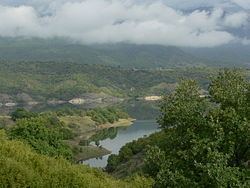Area 14.2 km² | Primary inflows Surface area 14.2 km (5.5 sq mi) Outflow location Tartar | |
 | ||
Water volume 560 million cubic metres (450,000 acre·ft) Similar Dadivank, Gandzasar monastery, Amaras Monastery, Lake Boyukshor, Lake Göygöl | ||
The Sarsang Reservoir (Armenian: Սարսանգի ջրամբար; Azerbaijani: Sərsəng su anbarı) is a large reservoir located in the Martakert Region of the unrecognised Nagorno-Karabakh Republic (de jure part of Azerbaijan), formed by a hydroelectric dam.
Contents
Map of Sarsang Reservoir
OverviewEdit
Sarsang Reservoir was built on Tartar River under Azerbaijani authority in 1976. The area of the reservoir is 14.2 km2 (5.5 sq mi). The overall volume of the reservoir is 575 million m3. The height of the dam at the reservoir is 125 m (410 ft). The reservoir has the tallest dam out of all dams in Azerbaijan. Since opening, the reservoir has provided irrigation water for 100,000 ha (250,000 acres) of agricultural lands in Tartar, Agdam, Barda, Goranboy, Yevlakh and Aghjabadi Districts of Azerbaijan. The Sarsang Hydro Power Plant with capacity of 50 megawatt has been based on the reservoir since its opening.
In November 1992, in the midst of the Nagorno-Karabakh War, the region of Mardakert came under effective Armenian control. The power plant, now operated by Artsakh HEK OJSC, has become the main source of electric energy for Nagorno-Karabakh (40–60%). Local authorities have expressed hopes for the reservoir to turn to a major tourism site in the long run.
Environmental concernsEdit
Azerbaijan has maintained that the Sarsang Reservoir, due to poor maintenance, poses a threat to nearly 400,000 people living in the Karabakh lowlands which remain under Azerbaijani control. The country has taken measures to minimise potential damage that water evacuation could cause. In addition, the exploitation of the reservoir by the Armenian side deprived farmers from seven Azerbaijani villages in the Tartar District from accessing water regularly.
In 2014, Bosnian member of the Parliamentary Assembly of the Council of Europe (PACE) Milica Marković prepared a report in which she outlined environmental risks brought upon by the lack of regular maintenance of the dam, as well as a possibility of the frontier regions of Azerbaijan being deprived of water supply as a result of intensive farming, industrial activities, climate change and consumer habits, but also policy mistakes on the part of the Nagorno-Karabakh authorities. On 26 January 2016, PACE (of which both Armenia and Azerbaijan are members) adopted Resolution 2085, whereby it deplored "the fact that the occupation by Armenia of Nagorno-Karabakh and other adjacent areas of Azerbaijan creates similar humanitarian and environmental problems for the citizens of Azerbaijan living in the Lower Karabakh valley" and requested the immediate withdrawal of Armenian armed forces from the region in order to allow independent engineers access to carry out an on-the-spot survey. The Assembly also recommended that the Armenian side stopped using water resources as tools of political influence or an instrument of pressure benefiting only one of the parties to the conflict.
In June 2016, the White House formally responded to a petition signed by over 330,000 people regarding the status of Nagorno-Karabakh and dangers posed by the Sarsang Reservoir. In the response, the Obama administration expressed its support of the PACE Resolution 2085 and said it would welcome a meeting between technical experts to discuss water management and dam inspections at the reservoir.
